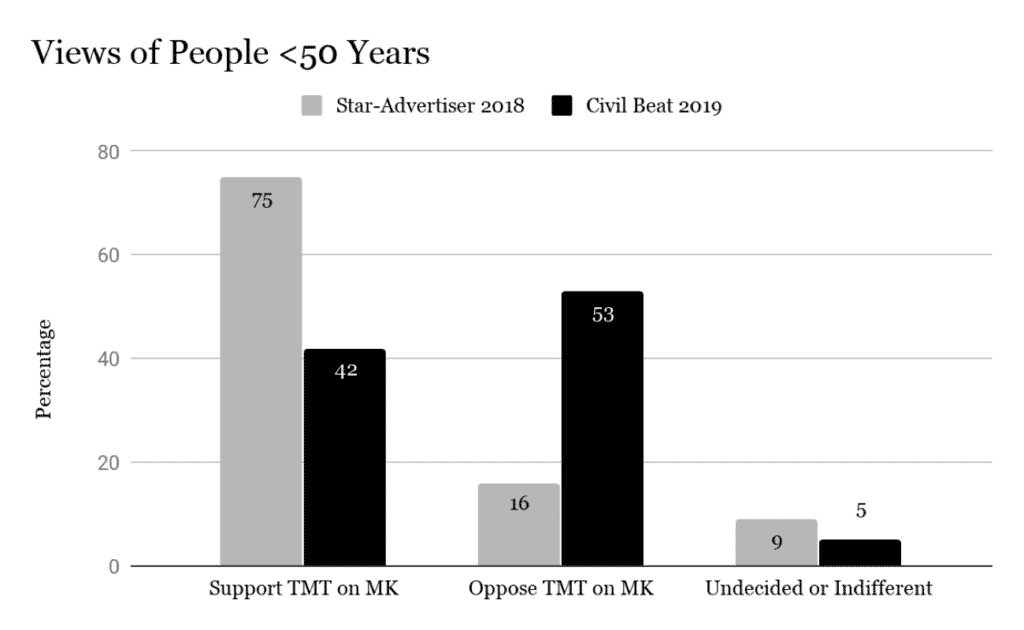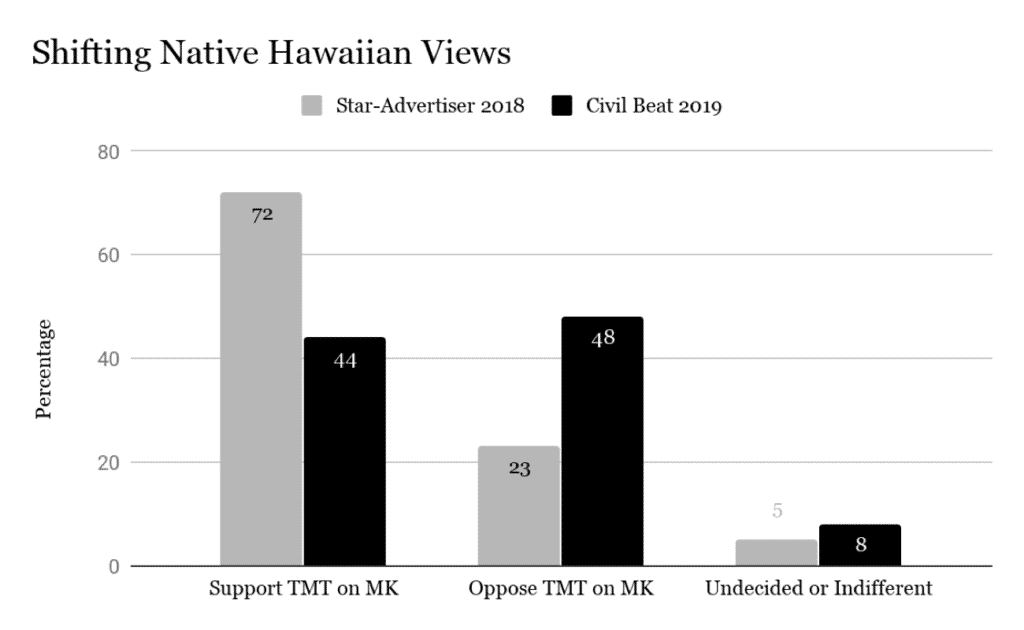Polls show eroding support for TMT, mounting support for Mauna Kea
Polls aren’t the best measure of a movement, but here’s one way to look at trends over a 17–month period
1
Shifting winds in favor of the kia‘i
Polls are often unreliable indicators of actual public sentiment, especially taken singly as a snapshot of a small sample of people at one moment in time. And yet they are crude tools we use to see which way the wind is blowing, so to speak, and how strongly the winds are gusting.
Taken as a pair, Star-Advertiser’s March 2018 poll* and Civil Beat’s August 2019 poll* clearly show the winds are shifting.

2
Mounting Opposition to the TMT
In 2018, Star-Advertiser reported that 15% of those polled opposed building the TMT on Mauna Kea, while Civil Beat reported that 31% of those polled opposed building the TMT on Mauna Kea. That’s a 16% increase in opposition to the project over a 17-month period.
Similarly, if you look at those who support the TMT, the same shift is clear. In 2018, 77% of those polled supported the TMT being built on Mauna Kea, but in 2019, only 64% of those polled supported the same. That’s a 13% decrease in support for the project.
When considering residents under 50 (those who will be most affected by decisions made today about Mauna Kea), the shift is even more compelling. In 2018, only 16% of those polled in this subgroup were opposed to building the TMT on Mauna Kea. Today, 53% of this polled subgroup oppose the project. That’s a whopping 37% increase in opposition.
3
Native Hawaiian Perspectives and Efforts
The shift is also clear among Native Hawaiians. In 2018, the Star-Advertiser reported that 72% of Native Hawaiians supported the TMT being built on Mauna Kea. Civil Beat’s 2019 poll showed that number dropped to 44%, a 28% decrease. Significantly, 48% of Native Hawaiians were in opposition to TMT being built on Mauna Kea (with 4% being undecided and 4% being indifferent).
More telling is that when asked a different question, even more people support the stance of the kiaʻi protecting Mauna Kea. Civil Beat reports that only 50% of those polled oppose the protests against the TMT, while 43% of those polled support the protests.
People polled also recognize the significance of this issue to Native Hawaiians. When asked about how the potential negative impact of the TMT on Native Hawaiian cultural practices affects their overall opinion of the project, 34% of those polled said that such considerations are “very important,” 29% said “somewhat important” and 27% said “not important.”
When you look at these poll results in concert, those polled seem to see that Hawaiians have a special stake in the future of Mauna Kea. And if so, shouldn’t Native Hawaiians have a stronger voice in determining what happens next?


4
The Big Picture
Some might point to the view that the majority of those Civil Beat polled (64%) still support building the TMT on Mauna Kea. However, in this moment in time, we need to keep our eye on the trend.
If we look at the big picture, the polls reveal the winds are strongly shifting. Hawaiʻi’s citizens are changing their views about Mauna Kea and TMT. People are learning about Mauna Kea, uncovering the many ways Mauna Kea has been mismanaged for over half a century, seeing the corruption in the TMT approval process, and witnessing how the protectors are standing up for Mauna Kea in kapu aloha. With that knowledge, support for protecting Mauna Kea is mounting. Support for building the TMT on Mauna Kea is eroding.
If you are still on the fence, or if you want to learn more and make a sound choice about where to stand, check out these resources:
*Both the Star-Advertiser and Civil Beat polls are significantly flawed. The first problem is that they are using a very tiny sample to extrapolate to a much larger population. There are 1.42 million Hawaiʻi residents. However, the Star-Advertiser poll sampled a population of only 800 individuals (.056 percent of the actual population), and the Civil Beat poll sampled a population of 1,367 people (.096 percent of the actual population). Such a small sample makes it difficult for the poll to truly represent the diversity of the actual population. Additionally, the Civil Beat poll results were oddly weighted to reflect a mix of 60% landline and 40% cell phone users. A bigger problem is that the polls only included registered voters. In Hawaiʻi, where only 54% of adults are registered voters, that means that 46% of the population were excluded from the outset. This might make sense to predict the outcome of an election. But that limitation seems inappropriate to gauge the views of Hawaiʻi residents as a whole.

